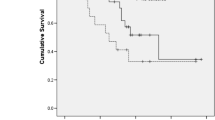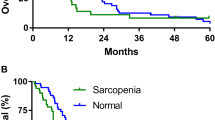Abstract
Purpose
Advanced non-small cell lung cancer (NSCLC) is associated with weight loss which may reflect skeletal muscle mass (SMM) and/or total adipose tissue (TAT) depletion. This study aimed to describe changes in body composition (BC) parameters and to identify the factors unrelated to the tumor which modulate them.
Methods
SMM, TAT, and the proportion of SMM to SMM + TAT were assessed with computed tomography. Estimates of each BC parameter at follow-up initiation and across time were derived from a mixed linear model of repeated measurements with a random intercept and a random slope. The same models were used to assess the independent effect of gender, age, body mass index (BMI), and initial values on changes in each BC parameter.
Results
Sixty-four patients with stage III or IV NSCLC were reviewed. The mean ± SD decreases in body weight and SMM were respectively 59 ± 3 g/week (P < 0.03) and 7 mm2/m2/week (P = 0.0003). During follow-up, no changes were identified in TAT nor in muscle density or in the proportion of SMM to SMM + TAT, estimated at 37 ± 2% at baseline. SMM loss was influenced by initial BMI (P < 0.0001) and SMM values (P = 0.0002): the higher the initial BMI or SMM values, the greater the loss observed. Weight loss was greater when the initial weight was heavier (P < 0.0001).
Conclusion
Our results demonstrate that SMM wasting in NSCLC is lower when initial SMM and BMI values are low. These exploratory findings after our attempt to better understand the intrinsic factors associated with muscle mass depletion need to be confirmed in larger studies.


Similar content being viewed by others
References
Ferlay J, Soerjomataram I, Dikshit R, Eser S, Mathers C, Rebelo M, Parkin DM, Forman D, Bray F (2015) Cancer incidence and mortality worldwide: sources, methods and major patterns in GLOBOCAN 2012. Int J Cancer 136(5):E359–E386. doi:10.1002/ijc.29210
Brundage MD, Davies D, Mackillop WJ (2002) Prognostic factors in non-small cell lung cancer: a decade of progress. Chest 122(3):1037–1057
Mountain CF (1993) Lung cancer staging classification. Clin Chest Med 14(1):43–53
Nourissat A, Bairati I, Fortin A, Gelinas M, Nabid A, Brochet F, Tetu B, Meyer F (2012) Factors associated with weight loss during radiotherapy in patients with stage I or II head and neck cancer. Support Care Cancer: Off J Multinatl Assoc Support Care Cancer 20(3):591–599. doi:10.1007/s00520-011-1132-x
Scott HR, McMillan DC, Brown DJ, Forrest LM, McArdle CS, Milroy R (2003) A prospective study of the impact of weight loss and the systemic inflammatory response on quality of life in patients with inoperable non-small cell lung cancer. Lung Cancer 40(3):295–299
von Meyenfeldt M (2005) Cancer-associated malnutrition: an introduction. Eur J Oncol Nurs 9(Suppl 2):S35–S38. doi:10.1016/j.ejon.2005.09.001
Temel J (2004) Can weight loss at presentation predict patient outcome in lung cancer? Nat Clin Pract Oncol 1(2):68–69. doi:10.1038/ncponc0033
Prado CM, Baracos VE, McCargar LJ, Reiman T, Mourtzakis M, Tonkin K, Mackey JR, Koski S, Pituskin E, Sawyer MB (2009) Sarcopenia as a determinant of chemotherapy toxicity and time to tumor progression in metastatic breast cancer patients receiving Capecitabine treatment. Clin Cancer Res: Off J Am Assoc Cancer Res 15(8):2920–2926. doi:10.1158/1078-0432.CCR-08-2242
Martin L, Birdsell L, Macdonald N, Reiman T, Clandinin MT, McCargar LJ, Murphy R, Ghosh S, Sawyer MB, Baracos VE (2013) Cancer cachexia in the age of obesity: skeletal muscle depletion is a powerful prognostic factor, independent of body mass index. J Clin Oncol 31(12):1539–1547. doi:10.1200/JCO.2012.45.2722
Chemama S, Bayar MA, Lanoy E, Ammari S, Stoclin A, Goere D, Elias D, Raynard B, Antoun S (2016) Sarcopenia is associated with chemotherapy toxicity in patients undergoing cytoreductive surgery with hyperthermic intraperitoneal chemotherapy for peritoneal carcinomatosis from colorectal cancer. Ann Surg Oncol. doi:10.1245/s10434-016-5360-7
Antoun S, Borget I, Lanoy E (2013) Impact of sarcopenia on the prognosis and treatment toxicities in patients diagnosed with cancer. Curr Opin Support Palliat Care 7(4):383–389. doi:10.1097/SPC.0000000000000011
Cousin S, Hollebecque A, Koscielny S, Mir O, Varga A, Baracos VE, Soria JC, Antoun S (2014) Low skeletal muscle is associated with toxicity in patients included in phase I trials. Investig New Drugs 32(2):382–387. doi:10.1007/s10637-013-0053-6
McMillan DC, Watson WS, Preston T, McArdle CS (2000) Lean body mass changes in cancer patients with weight loss. Clin Nutr 19(6):403–406. doi:10.1054/clnu.2000.0136
Fearon K, Strasser F, Anker SD, Bosaeus I, Bruera E, Fainsinger RL, Jatoi A, Loprinzi C, MacDonald N, Mantovani G, Davis M, Muscaritoli M, Ottery F, Radbruch L, Ravasco P, Walsh D, Wilcock A, Kaasa S, Baracos VE (2011) Definition and classification of cancer cachexia: an international consensus. Lancet Oncol 12(5):489–495. doi:10.1016/S1470-2045(10)70218-7
Baracos VE, Reiman T, Mourtzakis M, Gioulbasanis I, Antoun S (2010) Body composition in patients with non-small cell lung cancer: a contemporary view of cancer cachexia with the use of computed tomography image analysis. Am J Clin Nutr 91(4):1133S–1137S. doi:10.3945/ajcn.2010.28608C
Barber MD, McMillan DC, Preston T, Ross JA, Fearon KC (2000) Metabolic response to feeding in weight-losing pancreatic cancer patients and its modulation by a fish-oil-enriched nutritional supplement. Clin Sci 98(4):389–399
Lieffers JR, Mourtzakis M, Hall KD, McCargar LJ, Prado CM, Baracos VE (2009) A viscerally driven cachexia syndrome in patients with advanced colorectal cancer: contributions of organ and tumor mass to whole-body energy demands. Am J Clin Nutr 89(4):1173–1179. doi:10.3945/ajcn.2008.27273
Prado CM, Sawyer MB, Ghosh S, Lieffers JR, Esfandiari N, Antoun S, Baracos VE (2013) Central tenet of cancer cachexia therapy: do patients with advanced cancer have exploitable anabolic potential? Am J Clin Nutr 98(4):1012–1019. doi:10.3945/ajcn.113.060228
Prado CM, Lieffers JR, McCargar LJ, Reiman T, Sawyer MB, Martin L, Baracos VE (2008) Prevalence and clinical implications of sarcopenic obesity in patients with solid tumours of the respiratory and gastrointestinal tracts: a population-based study. Lancet Oncol 9(7):629–635. doi:10.1016/S1470-2045(08)70153-0
Malietzis G, Currie AC, Johns N, Fearon KC, Darzi A, Kennedy RH, Athanasiou T, Jenkins JT (2016) Skeletal muscle changes after elective colorectal cancer resection: a longitudinal study. Ann Surg Oncol 23(8):2539–2547. doi:10.1245/s10434-016-5188-1
Baracos VE, Reiman T, Mourtzakis M, Gioulbasanis I, Antoun S (2010) Body composition in patients with non-small cell lung cancer: a contemporary view of cancer cachexia with the use of computed tomography image analysis. Am J Clin Nutr 91(4):1133S–1137S. doi:10.3945/ajcn.2010.28608C
Palomares MR, Sayre JW, Shekar KC, Lillington LM, Chlebowski RT (1996) Gender influence on weight-loss pattern and survival of nonsmall cell lung carcinoma patients. Cancer 78(10):2119–2126
Yang R, Cheung MC, Pedroso FE, Byrne MM, Koniaris LG, Zimmers TA (2011) Obesity and weight loss at presentation of lung cancer are associated with opposite effects on survival. J Surg Res 170(1):e75–e83. doi:10.1016/j.jss.2011.04.061
Patel JD, Pereira JR, Chen J, Liu J, Guba SC, John WJ, Orlando M, Scagliotti G, Bonomi PD (2016) Relationship between efficacy outcomes and weight gain during treatment of advanced, non-squamous, non-small-cell lung cancer patients. Ann Oncol: Off J Eur Soc Med Oncol/ ESMO. doi:10.1093/annonc/mdw211
Di Sebastiano KM, Yang L, Zbuk K, Wong RK, Chow T, Koff D, Moran GR, Mourtzakis M (2013) Accelerated muscle and adipose tissue loss may predict survival in pancreatic cancer patients: the relationship with diabetes and anaemia. Br J Nutr 109(2):302–312. doi:10.1017/S0007114512001067
Awad S, Tan BH, Cui H, Bhalla A, Fearon KC, Parsons SL, Catton JA, Lobo DN (2012) Marked changes in body composition following neoadjuvant chemotherapy for oesophagogastric cancer. Clin Nutr 31(1):74–77. doi:10.1016/j.clnu.2011.08.008
Collins J, Noble S, Chester J, Coles B, Byrne A (2014) The assessment and impact of sarcopenia in lung cancer: a systematic literature review. BMJ Open 4(1):e003697. doi:10.1136/bmjopen-2013-003697
Goldbohm RA, Voorrips LE (2000) Epidemiology of nutrition and lung cancer. Nestle Nutr Workshop Ser Clin Perform Programme 4:23–35 discussion 35-27
Ridge CA, McErlean AM, Ginsberg MS (2013) Epidemiology of lung cancer. Semin Intervent Radiol 30(2):93–98. doi:10.1055/s-0033-1342949
Rivera MP (2009) Lung cancer in women: the differences in epidemiology, biology and treatment outcomes. Expert Rev Respir Med 3(6):627–634. doi:10.1586/ers.09.54
Antoun S, Lanoy E, Iacovelli R, Albiges-Sauvin L, Loriot Y, Merad-Taoufik M, Fizazi K, di Palma M, Baracos VE, Escudier B (2013) Skeletal muscle density predicts prognosis in patients with metastatic renal cell carcinoma treated with targeted therapies. Cancer 119(18):3377–3384. doi:10.1002/cncr.28218
Shen W, Punyanitya M, Wang Z, Gallagher D, St-Onge MP, Albu J, Heymsfield SB, Heshka S (2004) Total body skeletal muscle and adipose tissue volumes: estimation from a single abdominal cross-sectional image. J Appl Physiol (Bethesda, Md : 1985) 97(6):2333–2338. doi:10.1152/japplphysiol.00744.2004
Goodpaster BH, Kelley DE, Thaete FL, He J, Ross R (2000) Skeletal muscle attenuation determined by computed tomography is associated with skeletal muscle lipid content. J Appl Physiol (Bethesda, Md : 1985) 89(1):104–110
Ross PJ, Ashley S, Norton A, Priest K, Waters JS, Eisen T, Smith IE, O’Brien ME (2004) Do patients with weight loss have a worse outcome when undergoing chemotherapy for lung cancers? Br J Cancer 90(10):1905–1911. doi:10.1038/sj.bjc.6601781
Stene GB, Helbostad JL, Amundsen T, Sorhaug S, Hjelde H, Kaasa S, Gronberg BH (2015) Changes in skeletal muscle mass during palliative chemotherapy in patients with advanced lung cancer. Acta Oncol 54(3):340–348. doi:10.3109/0284186X.2014.953259
Williams JP, Phillips BE, Smith K, Atherton PJ, Rankin D, Selby AL, Liptrot S, Lund J, Larvin M, Rennie MJ (2012) Effect of tumor burden and subsequent surgical resection on skeletal muscle mass and protein turnover in colorectal cancer patients. Am J Clin Nutr 96(5):1064–1070. doi:10.3945/ajcn.112.045708
Gallagher D, Visser M, De Meersman RE, Sepulveda D, Baumgartner RN, Pierson RN, Harris T, Heymsfield SB (1997) Appendicular skeletal muscle mass: effects of age, gender, and ethnicity. J Appl Physiol (Bethesda, Md : 1985) 83(1):229–239
Kelly TL, Wilson KE, Heymsfield SB (2009) Dual energy X-ray absorptiometry body composition reference values from NHANES. PLoS One 4(9):e7038. doi:10.1371/journal.pone.0007038
Wallengren O, Iresjo BM, Lundholm K, Bosaeus I (2015) Loss of muscle mass in the end of life in patients with advanced cancer. Support Care Cancer: Off J Multinatl Assoc Support Care Cancer 23(1):79–86. doi:10.1007/s00520-014-2332-y
Stephens NA, Gray C, MacDonald AJ, Tan BH, Gallagher IJ, Skipworth RJ, Ross JA, Fearon KC, Greig CA (2012) Sexual dimorphism modulates the impact of cancer cachexia on lower limb muscle mass and function. Clin Nutr 31(4):499–505. doi:10.1016/j.clnu.2011.12.008
Forbes GB (2000) Body fat content influences the body composition response to nutrition and exercise. Ann N Y Acad Sci 904:359–365
Haas VK, Kohn MR, Clarke SD, Allen JR, Madden S, Muller MJ, Gaskin KJ (2009) Body composition changes in female adolescents with anorexia nervosa. Am J Clin Nutr 89(4):1005–1010. doi:10.3945/ajcn.2008.26958
Casaer MP, Langouche L, Coudyzer W, Vanbeckevoort D, De Dobbelaer B, Guiza FG, Wouters PJ, Mesotten D, Van den Berghe G (2013) Impact of early parenteral nutrition on muscle and adipose tissue compartments during critical illness. Crit Care Med 41(10):2298–2309. doi:10.1097/CCM.0b013e31828cef02
Dietze D, Ramrath S, Ritzeler O, Tennagels N, Hauner H, Eckel J (2004) Inhibitor kappaB kinase is involved in the paracrine crosstalk between human fat and muscle cells. Int J Obes Relat Metab Disord: J Int Assoc Study Obes 28(8):985–992. doi:10.1038/sj.ijo.0802701
Das SK, Eder S, Schauer S, Diwoky C, Temmel H, Guertl B, Gorkiewicz G, Tamilarasan KP, Kumari P, Trauner M, Zimmermann R, Vesely P, Haemmerle G, Zechner R, Hoefler G (2011) Adipose triglyceride lipase contributes to cancer-associated cachexia. Science 333(6039):233–238. doi:10.1126/science.1198973
Akahori T, Sho M, Kinoshita S, Nagai M, Nishiwada S, Tanaka T, Tamamoto T, Ohbayashi C, Hasegawa M, Kichikawa K, Nakajima Y (2015) Prognostic significance of muscle attenuation in pancreatic cancer patients treated with neoadjuvant chemoradiotherapy. World J Surg 39(12):2975–2982. doi:10.1007/s00268-015-3205-3
Author information
Authors and Affiliations
Corresponding author
Ethics declarations
Conflict of interest
The authors declare that they have no conflict of interest.
Rights and permissions
About this article
Cite this article
Atlan, P., Bayar, M.A., Lanoy, E. et al. Factors which modulate the rates of skeletal muscle mass loss in non-small cell lung cancer patients: a pilot study. Support Care Cancer 25, 3365–3373 (2017). https://doi.org/10.1007/s00520-017-3755-z
Received:
Accepted:
Published:
Issue Date:
DOI: https://doi.org/10.1007/s00520-017-3755-z




